First, let us congratulate you. You’re researching product management software, which means you’ve already taken a big step toward making your product department more efficient and effective, not to mention leveling up your own product management game. You recognize that the right software, built just for product professionals, can help you increase efficiencies in your daily work, uncover valuable insights about your products and market, tell a more compelling product story to key stakeholders, and align your company around shared goals and plans.
As you probably know, most Product Managers are still using the wrong tools for their important strategic work. And that brings us to a word of warning about your software selection process.
Do you know why so many product professionals still build their roadmaps in PowerPoint and manage their backlogs using Excel — even though neither of these tools was built for that purpose and using them often adds hours of tedious tasks to Product Managers’ workweeks? The answer is simple inertia. Once they’ve gotten comfortable with a process or tool, they become resistant to changing it — even if it’s not the best or the most convenient.
So, it’s a good idea to take your time here and investigate product management software platforms thoroughly. If you roll out one solution to your team and later realize it’s missing key product management functionality, you could face a significant challenge persuading your coworkers and your company to migrate to a different tool. And as we’ll demonstrate below, you could definitely find yourself in that scenario if you select Productboard, a software solution that’s strong on a couple product management capabilities — primarily centralizing customer feedback — but lacking in most of the strategic functions your product team will need.
And that’s why we wrote this guide — to give you a practical summary of the capabilities, strengths, and weaknesses of the major product management software solutions available today, and to help you determine which ones are the best alternatives to Productboard.
What Is a Product Management Software Solution?
A product management solution is software designed specifically for the unique needs and workflows of product professionals. Those workflows include conceptualizing, planning, prioritizing, and managing products through their entire lifecycle.
For a single software platform to support all of these important strategic responsibilities in one digital environment, it must let you:
- Build, manage, and groom your backlog.
- Score backlog items and prioritize those that best address your OKRs and other metrics.
- Create personas, stories, and specs — and connect them to the relevant work.
- Build your roadmap and present it highlighting just the right details for each audience.
- Compile and study feedback — and connect it to the relevant epics or stories.
- Track development capacity so you know how and where to allocate resources.
- Gain portfolio-level insights into your company’s capacity, priorities, and plans.
- Sync your product data with your dev team’s work in Jira or other tools.
As you can see, a truly complete product management software solution needs to offer a lot of functionality. If you select a platform that falls short in some of these key areas, you’ll need to find other tools to complete those tasks — adding tedious app-hopping to your daily work and fragmenting your valuable strategic product data across multiple software platforms.
What to Check When Comparing Productboard Alternatives
When you’re investigating product management software tools, you want to review the functionality each solution offers against the types of strategic workflows your team needs to perform regularly. Specifically, you’re looking for potential gaps in these tools’ ability to support your mission-critical work.
With Productboard, we believe you’ll find several of these gaps — from minimal flexibility in applying prioritization frameworks to your backlog items, to a complete lack of capacity planning capabilities.
Productboard’s main drawback
In many of the company’s ads and product descriptions online, Productboard describes itself as a “customer-centric product management system.” And the “customer” they’re referring to in that statement isn’t you or your team — the actual Productboard users. What they’re saying is that Productboard helps you develop products designed around your customers’ needs.
That’s an appealing proposition. But the reason Productboard starts all of its marketing messages with “Understand what customers need…” is that the platform is primarily software for collecting and analyzing user feedback.
Indeed, Productboard seems to have built a set of rudimentary product management tools around an impressive feedback-analysis engine. And to give you a few examples of where this solution falls short:
- Productboard requires a lot of manual work (building templates, creating custom prioritization formulas, adjusting roadmap presentation views) to adapt to a Product Manager’s unique needs and workflows.
- Productboard offers only a few built-in prioritization frameworks.
- Productboard does not offer the familiar filter and sort capabilities of Excel — meaning Product Managers can’t quickly rearrange their data according to whichever criteria (date, size, priority level, etc.) they choose.
- Productboard offers no capacity planning functionality.
Now let’s review how Productboard measures up against its main competitors.
Productboard vs. craft.io
What is craft.io?
craft.io is a truly comprehensive product management software platform — something Productboard claims but falls short of actually delivering. Indeed, craft.io’s end-to-end platform offers as much functionality and convenience in every area of the platform (roadmapping, capacity planning, prioritization, etc.) that Productboard offers in its feedback management.
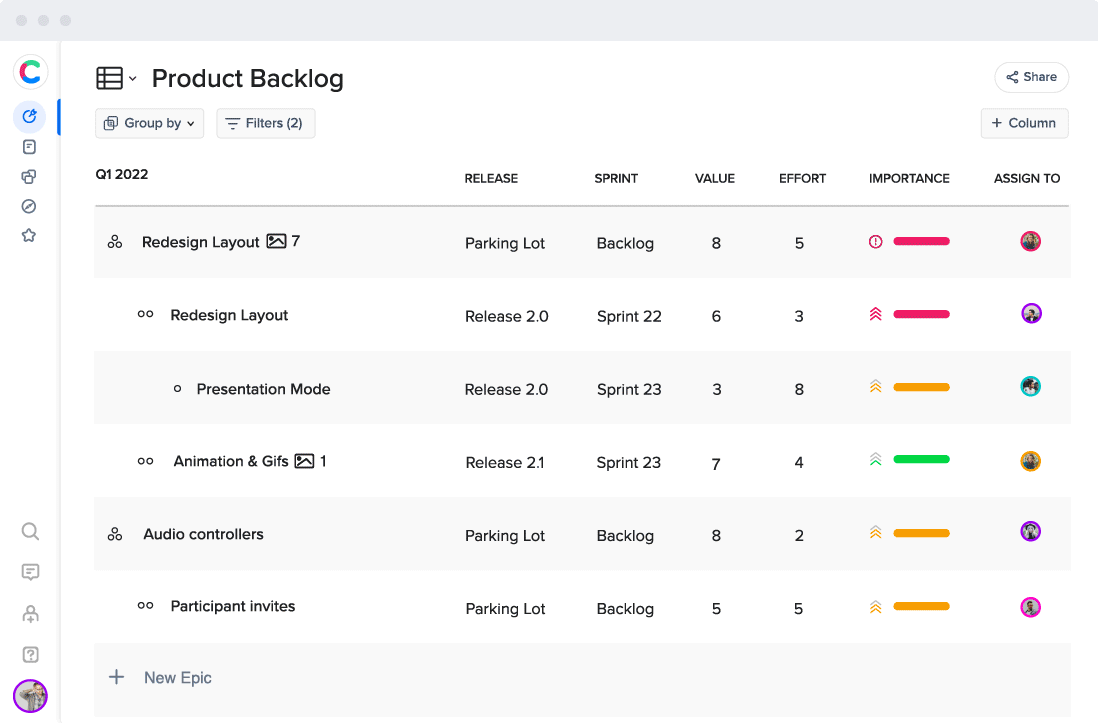
craft.io pros:
- Complete product management environment in a single pane of glass — centralizing roadmapping, prioritization, capacity planning, dependency management, etc.
- An intuitive data model: 4-item data hierarchy that aligns seamlessly with Jira.
- Ease of use: craft.io’s UX/UI is super clear and friendly.
- The Guru layer: A collection of best-practice templates to help Product Managers effortlessly apply proven best practices such as roadmap templates, prioritization frameworks, and strategic models, with just a click of a button.
- Excel-like UX: Excel-like table functionality to view, sort, and edit items properties directly in tables, create prioritization and apply capacity planning
- Infinite flexibility for viewing and presentation — from Kanban to swimlane to timeline in a few clicks.
- Seamless integrations with dev tools (Jira, Azure DevOps), visual collaboration apps (Miro, Axure), and design software (Figma, Adobe XD).
craft.io cons:
- Honestly, for product management teams looking for an end-to-end solution, we can’t find any drawbacks of this platform. We’ll keep looking, though, and we’ll update this page if we find any shortcomings to report.
Productboard vs. Aha!
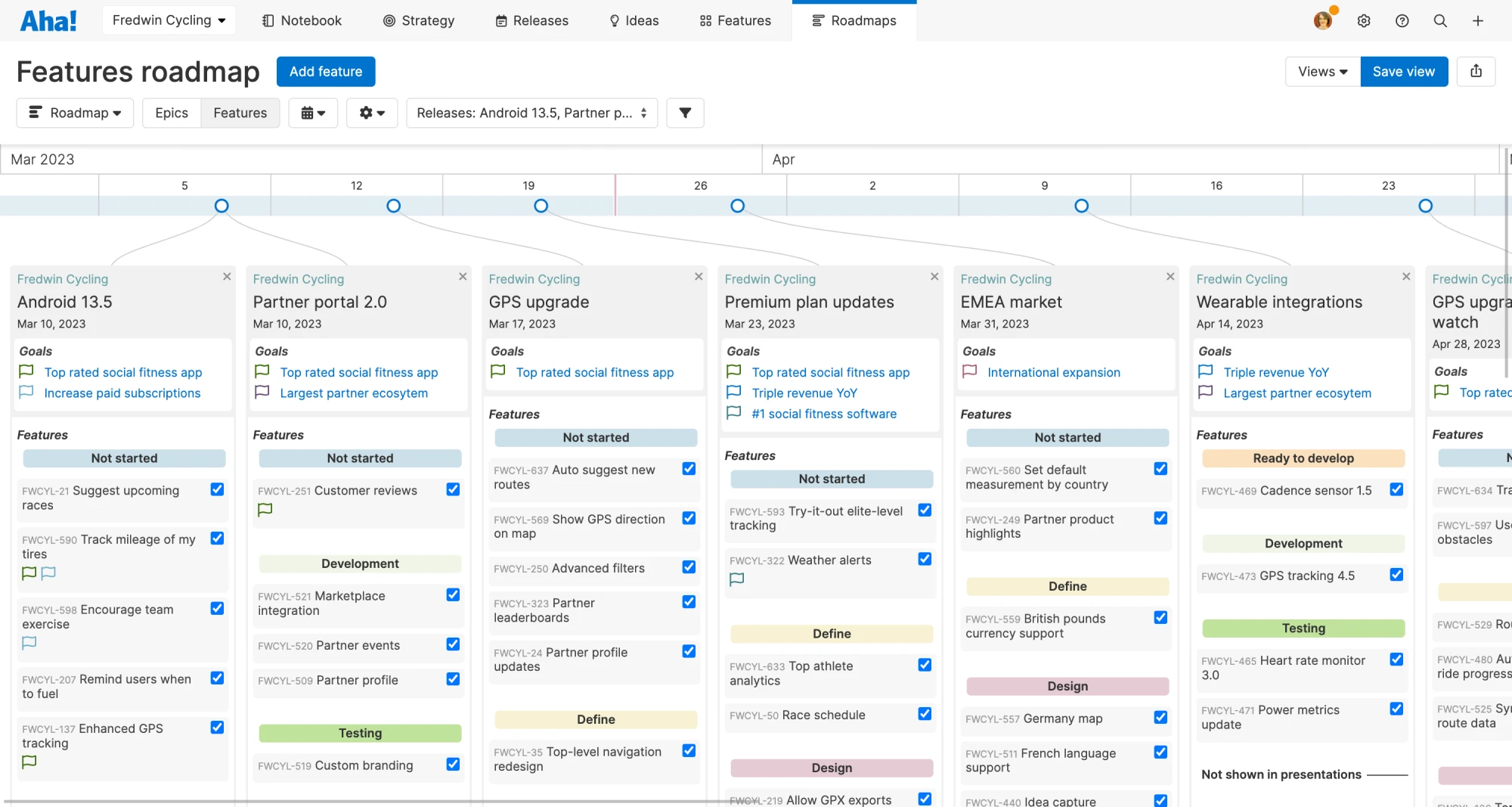
What is Aha!?
Aha! is one of the most widely used product management software platforms. And like Productboard, it offers functionality to support several key areas of product teams’ regular workflows —including roadmapping and backlog prioritization.
But also like Productboard, Aha! falls short of an outstanding user experience when it comes to most areas of the app. It offers only limited prioritization options, for example.
And here’s a warning: Aha! users also regularly complain that the app is difficult to learn and not very intuitive. In this respect, you might find Productboard a more appealing platform — if only because it presents its data in a cleaner, less-busy way. You can see from the screenshot here that to view your product information in Aha! can be a challenge — and presenting it might even give your audience a headache.
Aha! pros:
- Designed for Product Managers and their teams.
- Includes flexible roadmapping views.
- Strong integrations with numerous apps.
Aha! cons:
- Offers only one built-in prioritization framework.
- Creates a very complex and non-intuitive user experience.
- Doesn’t offer Excel-like functionality (to easily sort and order data sets by any column according to any criteria).
- Has a dated UI.
- Is quite expensive and not cost-effective for smaller teams.
Productboard vs. airfocus
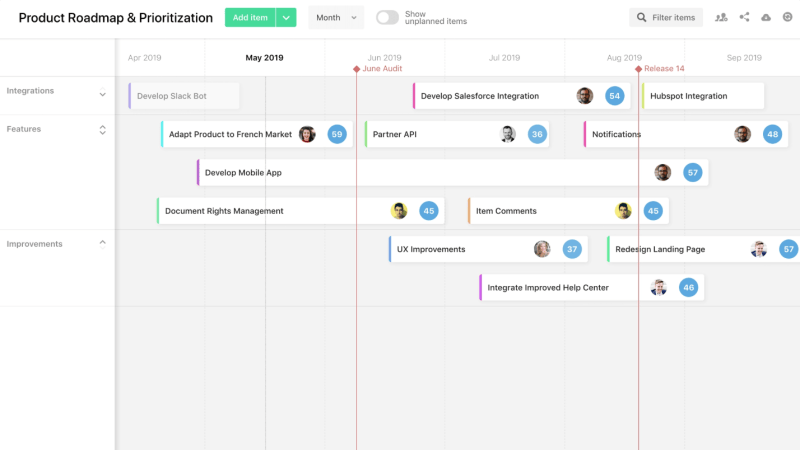
What is airfocus?
Although airfocus often describes itself as a product management solution — which is why we’re including it here — the platform is actually geared more for project management teams. Indeed, one of the product’s key areas of functionality is task-management, allowing project teams to assign, track, and update task-level work.
And while this solution does include some rudimentary product management functionality, it falls far short of representing the truly comprehensive digital hub your product team will need to manage your strategic work.
airfocus pros:
- Offers basic roadmapping capability.
- Includes a few built-in prioritization frameworks.
- Integrates with popular dev tools such as Jira and Azure DevOps.
airfocus cons:
- Doesn’t offer Excel-like functionality (to easily sort and order data sets by any column according to any criteria).
- Is quite expensive and not cost-effective for smaller teams.
- Lacks customization for roadmap views and presentation (a must-have for product teams that need to share strategic roadmaps with different stakeholders).
- Offers very limited prioritization capabilities.
- Does not offer built-in capacity planning.
- Lacks the ability to set and manage personas, establish OKRs, and connect these strategic elements to products or specific functionality.
Productboard vs. ProductPlan
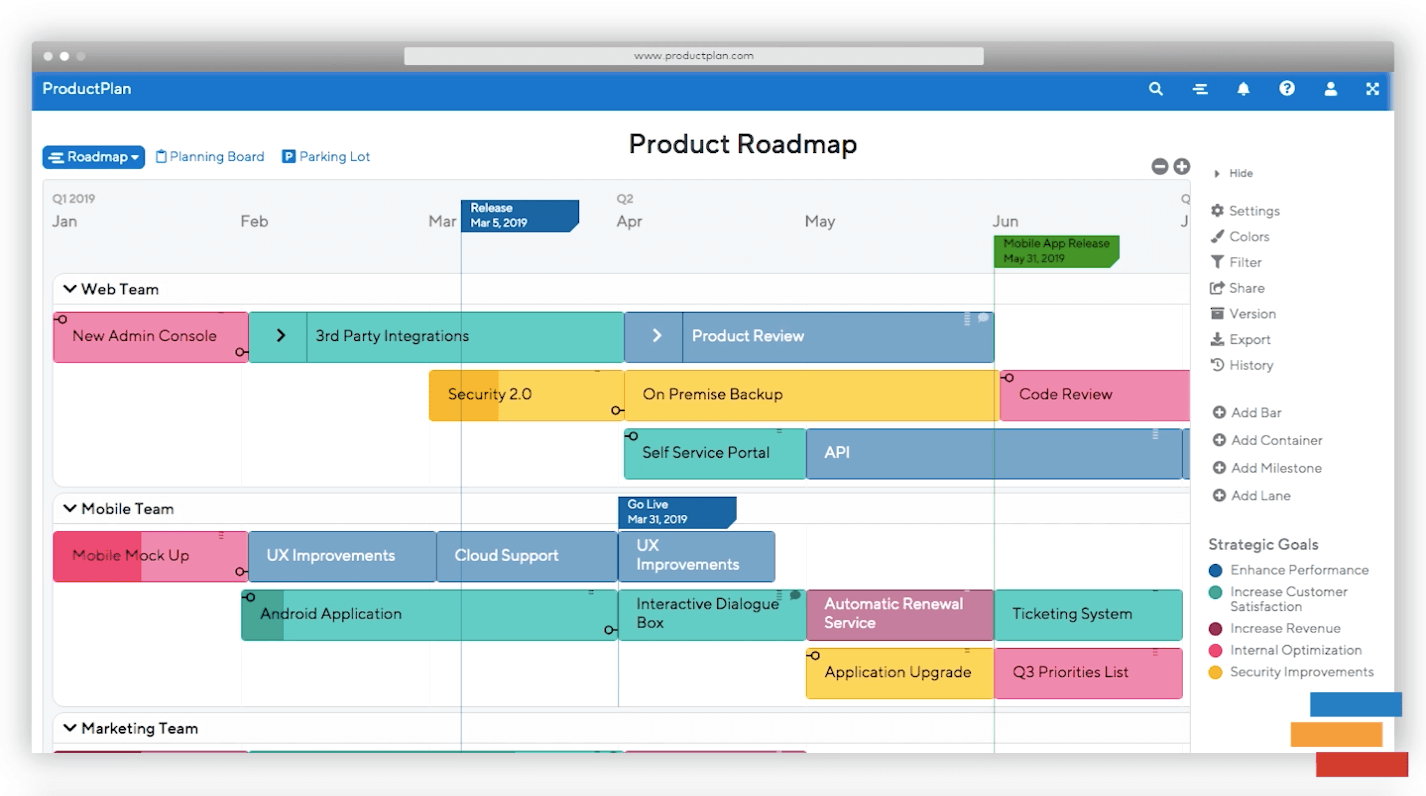
What is ProductPlan?
ProductPlan was one of the early software apps built for Product Managers — specifically, for product roadmapping. And today, ProductPlan offers an intuitive roadmapping experience.
Unfortunately, though, that represents most of the app’s capability. ProductPlan offers no built-in capacity planning, very little in the way of prioritization frameworks, and no built-in templates to save product teams time.
ProductPlan pros:
- Offers a strong roadmapping experience, with templates for several types of roadmaps.
- Integrates with popular dev tools such as Jira and Azure DevOps.
ProductPlan cons:
- Includes only a couple of views for your product data: roadmap and backlog.
- Includes very little prioritization capability — you’ll have to manually input your own formulas.
- Lacks capacity planning capabilities.
- Doesn’t offer Excel-like functionality (to easily sort and order data sets by any column according to any criteria).
Productboard vs. Airtable
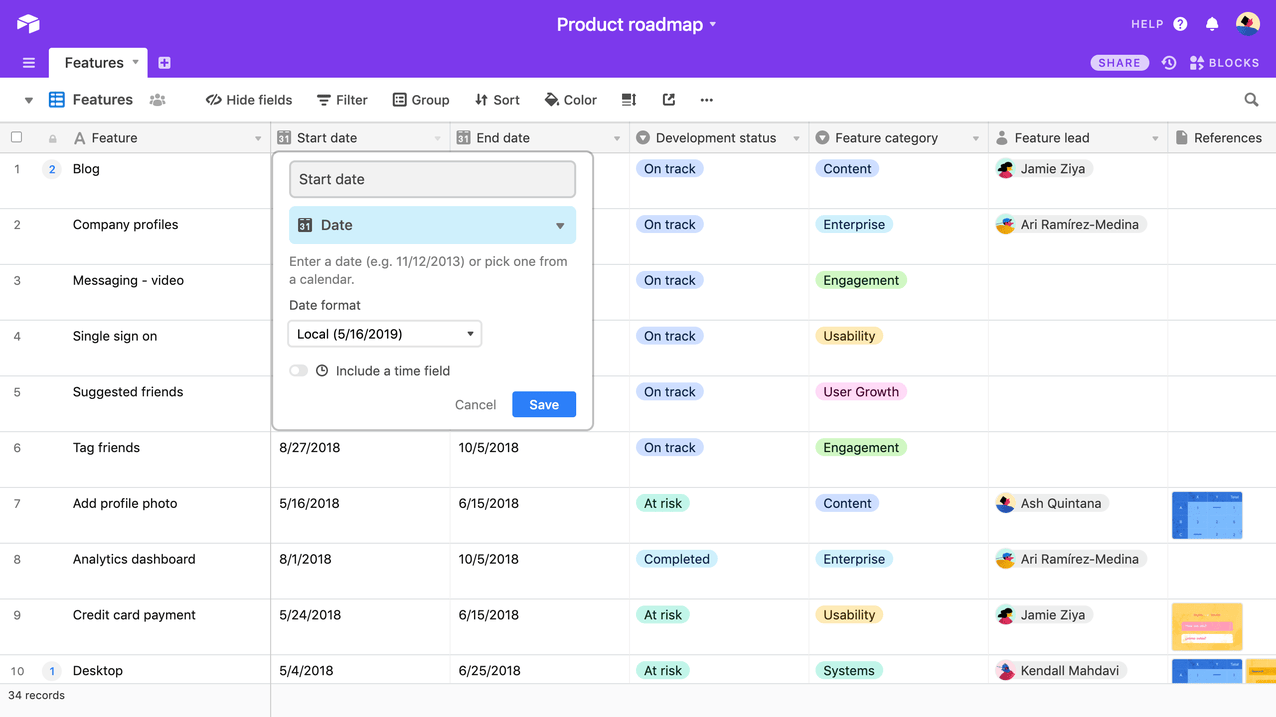
What is Airtable?
On Airtable’s homepage, you’ll find this headline: “Everyone’s app platform.”
And if you’ve read this far, you know why that’s a red flag: You’re looking for a software solution purpose-built for Product Managers and their teams — not a general business app that promises to streamline workflows for teams across the company.
For Airtable, that promise extends to marketing, product, operations, human resources, sales, finance, and other departments.
Airtable pros:
- Offers customer feedback collection.
- Lets users build a standard product roadmap (although with limited options for visual presentation).
- Allows users to connect roadmap items to OKRs.
Airtable cons:
- Not a complete product management platform.
- Does not include prioritization frameworks you can apply with a single click. In fact, the app asks users to “customize your own” formulas.)
- Lacks capacity planning and resource-allocation capabilities.
Productboard vs. Jira

What is Jira?
Jira calls itself “The #1 software development tool for agile teams.” That’s probably accurate. But like the Airtable self-description we just reviewed, this one also raises a red flag. Development and product management are obviously very different disciplines, with different workflows, and which require different toolsets.
Jira is an outstanding tool for helping engineers and software developers assign, monitor, and track their progress on tasks. And in recent years, Jira has made strides to expand its app to include some of the tools product management teams need as well.
But it’s important to remember that Jira was not designed for Product Managers. The app’s newer tools — such as product roadmapping — are really only add-ons to the product’s core functionality and purpose, which is to help development teams stay aligned and moving forward on their tasks.
Jira pros:
- An invaluable integration into purpose-built product management software.
- Can help Product Managers directly monitor their dev teams’ progress on tasks.
- Includes product roadmapping capability.
Jira cons:
- Not designed to be product management software.
- Does not offer strategic-level planning or prioritization functionality.
Productboard vs. Asana

What is Asana?
Like Jira, Asana is used far more for task management than for product management. That’s why on the app’s homepage you’ll find this promise: “Track, manage, and connect your projects across any team with Asana.”
And just as Jira provides an outstanding user experience for development teams, Asana is an excellent tool for managing tasks and complex projects.
But Asana wasn’t designed specifically for product management departments or to meet the unique strategic workflows of Product Managers. And as a result, you’ll find this app lacking in many of the capabilities you need to effectively manage your products.
Asana pros:
- Excellent collaboration platform.
- Helps teams across a company assign and track tasks as well as manage long-term, complex initiatives.
Asana cons:
- Not a product management solution.
- Doesn’t include essential product management elements such as built-in prioritization frameworks.
Productboard vs. ProdPad
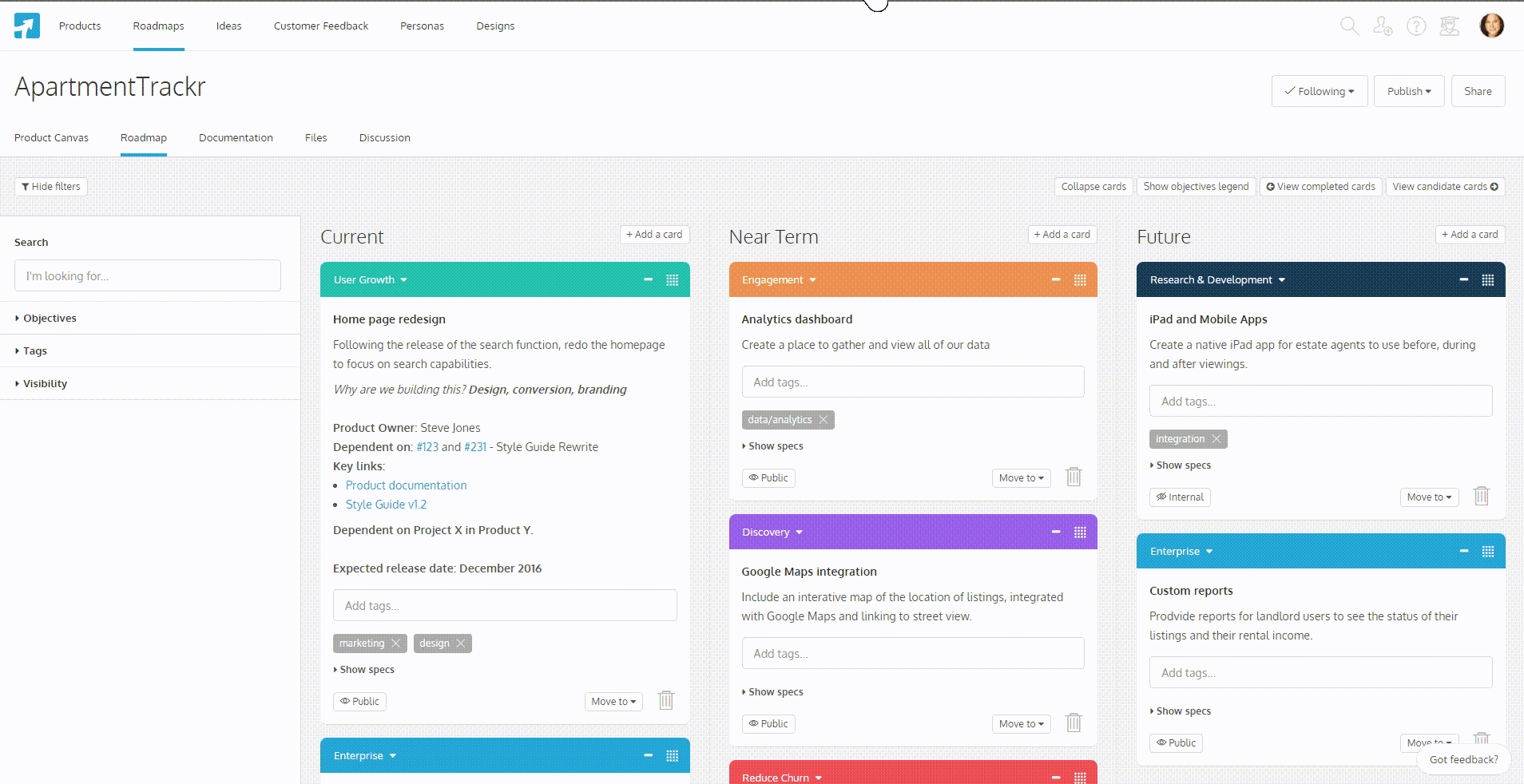
What is ProdPad?
After reviewing app after app that describes itself in project management terms, it’s refreshing to be once again discussing a software solution that refers to itself as a “product management platform.” ProdPad is indeed designed specifically for Product Managers.
But unfortunately, this is another example of a point solution — like Productboard itself — an app that delivers some product management functionality but is far from an end-to-end product management solution.
ProdPad pros:
- Enables product backlog management.
- Offers several roadmapping views.
- Lets teams connect roadmap items to OKRs.
ProdPad cons:
- Lacks built-in prioritization frameworks and requires a lot of manual inputs to score competing backlog items.
- No capacity planning.
- No Excel-like functionality (to easily sort and order data sets by any column according to any criteria).
- No product portfolio management capabilities.
- Offers only a very limited integration with Jira.
Productboard vs. Roadmunk
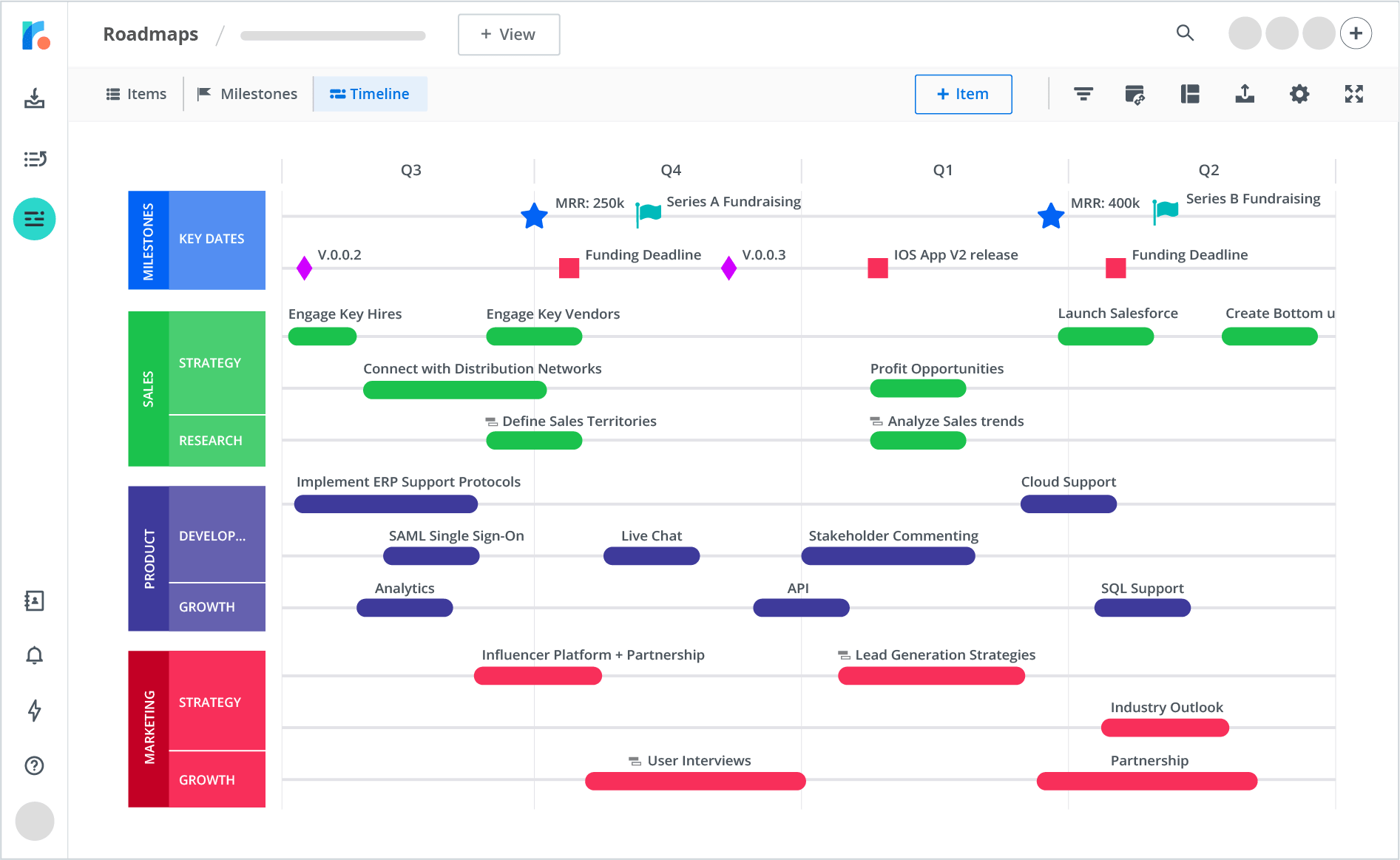
What is Roadmunk?
As its name hints, Roadmunk is another point solution for product teams. The company’s homepage describes the app as “The Top Agile Roadmapping Solution.”
And as important as roadmaps are to your strategic work as a Product Manager, you know they don’t represent the whole picture. What about capacity planning? What about built-in templates for creating stories, specs, and user personas? What about being able to display your product data using whatever views or levels of detail are most relevant?
Unfortunately, these are all questions you might find yourself asking Roadmunk’s product team.
Roadmunk pros:
- Provides a highly effective roadmapping experience.
- Offers two prioritization templates for scoring backlog items.
Roadmunk cons:
- Not a complete product management solution (by far).
- No portfolio-level product management.
- No capacity planning.
- No Excel-like functionality (to easily sort and order data sets by any column according to any criteria).
- No built-in templates for persona development, user story or feature creation, etc.
Productboard vs. Dragonboat
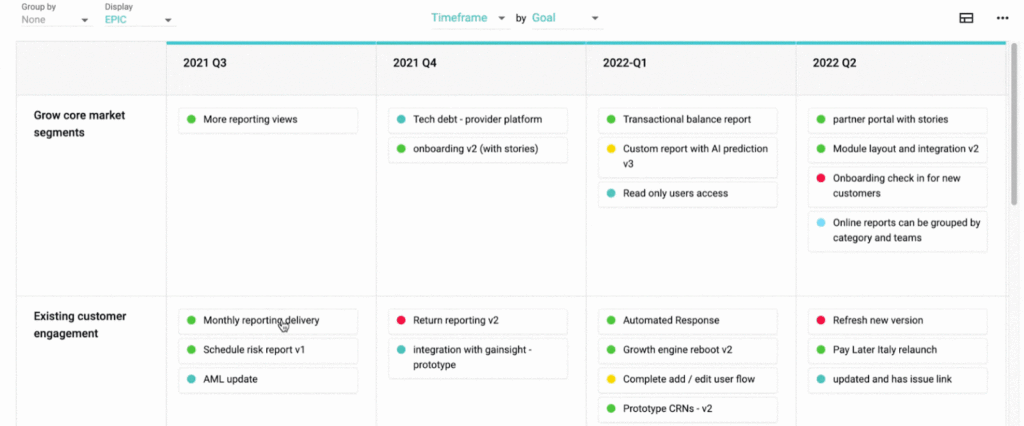
What is Dragonboat?
Dragonboat is unique among the tools we’re reviewing here because unlike the others, this one is aimed at product executives. Indeed, Dragonboat calls itself a “product portfolio platform,” a solution that helps product leaders more effectively manage their portfolio and business.
Product portfolio management isn’t functionality you’ll find with many of the tools we’ve discussed so far (with a couple of exceptions, such as craft.io). If you’re a product leader and this is your focus, Dragonboat might be worth further investigation.
But if you’re trying to find a comprehensive digital environment for your product management team’s work — a single source of product truth for your company — you’ll find Dragonboat severely lacking.
Dragonboat pros:
- Enables management at the product portfolio level. (Ideal for product leaders and product portfolio managers.)
- Centralizes and helps prioritize feature requests.
- Integrates with key apps such as Jira, Azure DevOps, and Slack.
Dragonboat cons:
- Not an end-to-end product management platform.
- Offers only a couple of built-in prioritization frameworks.
- No Excel-like functionality (to easily sort and order data sets by any column according to any criteria).
Productboard vs. Canny
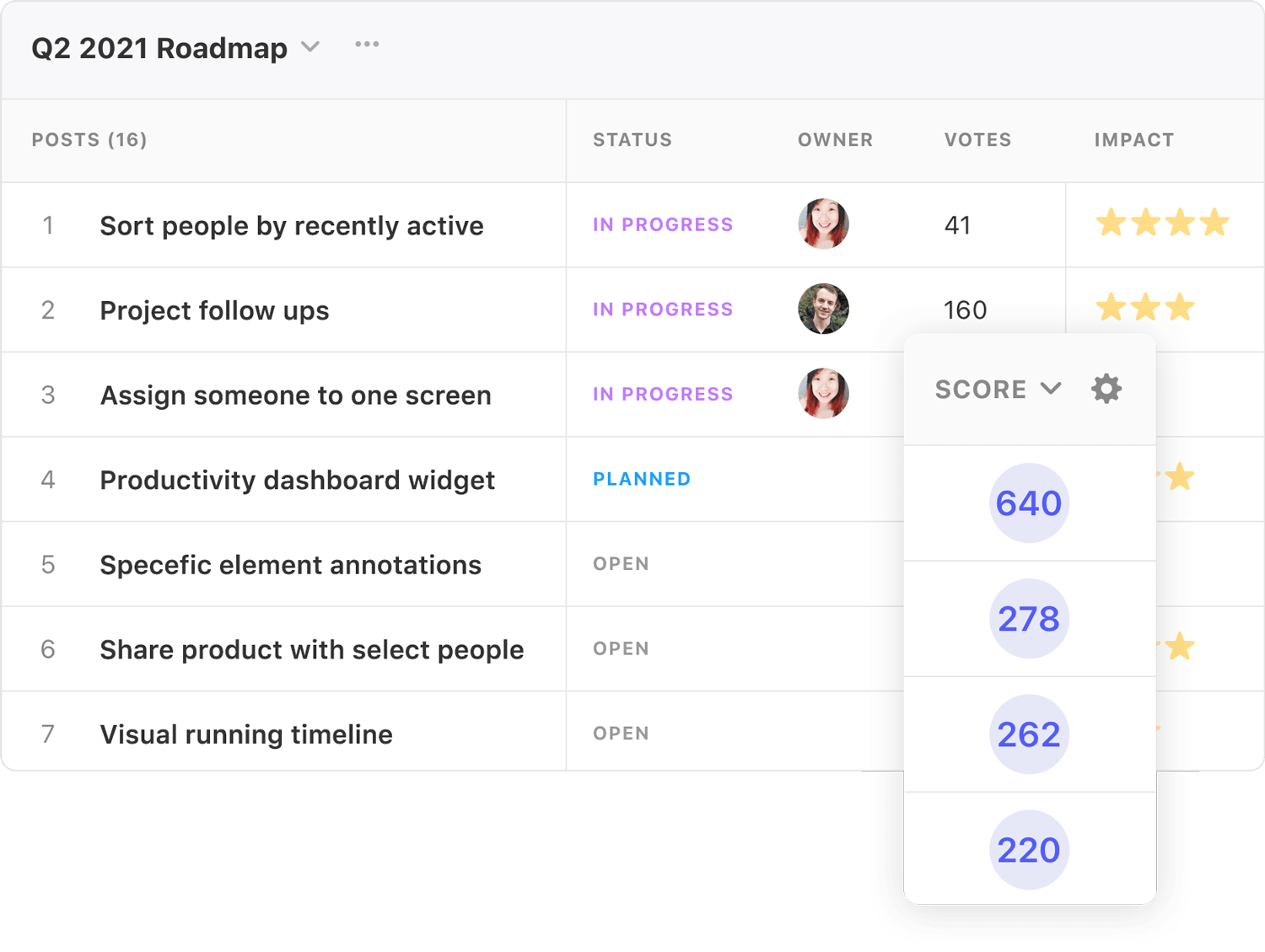
What is Canny?
Here’s the main value proposition Canny presents on its homepage: “Capture, organize, and analyze product feedback in one place to inform your product decisions.”
Canny and Productboard are both software applications whose core capability is helping users collect and make sense of customer feedback. In other words, Canny, like Productboard, is a point solution for product teams — not a comprehensive product management platform.
Canny pros:
- Powerful feedback collection and analysis tools.
- Allows teams to prioritize and clearly label work (“New,” “Improve,” “Fix,” etc.) based on feedback received.
- Helps to align teams across the company around a shared understanding of what users are saying about the products.
Canny cons:
- Not a complete product management platform.
- Offers very limited roadmapping functionality and flexibility.
- Does not include built-in prioritization frameworks, capacity planning, or other key product management capabilities.
Productboard vs. Monday.com

What is Monday.com?
Of all the Productboard alternatives in this review guide, Monday.com is one of the furthest away in terms of functionality and purpose. The company describes its app as a “Work OS” that lets teams create any workflow they want, including “Marketing, CRM, HR, software development, construction, video production, and so much more.”
In other words, this app is flexible but far from a purpose-built platform for Product Managers and their teams.
Monday.com pros:
- Great tool for creating workflows and cross-team collaboration.
- Ideal platform for project and task management.
Monday.com cons:
- Not a product management solution.
- Very few Product Manager-specific capabilities beyond a very basic roadmap view.
Productboard vs. Clickup
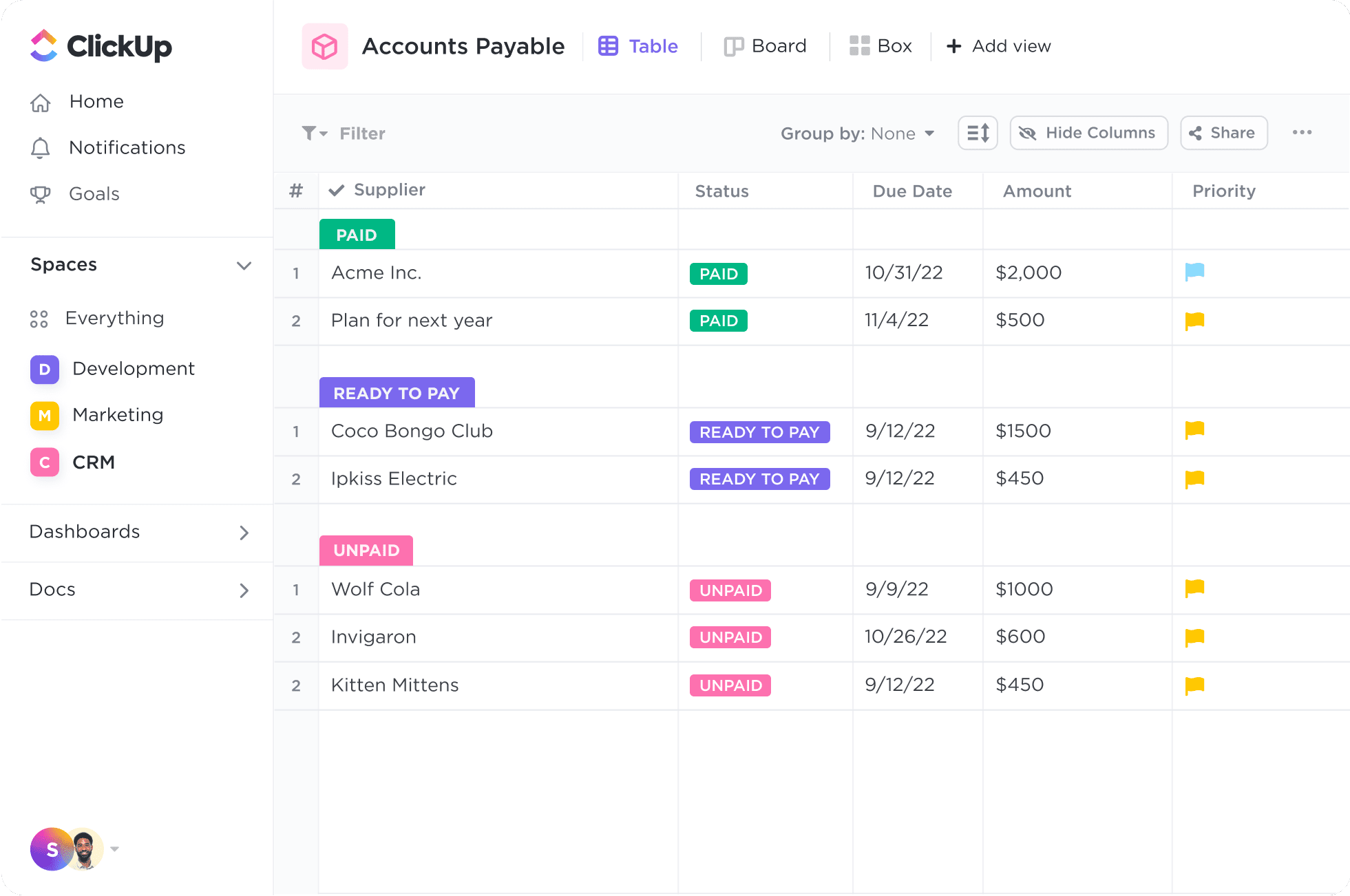
What is ClickUp?
Like many of the apps we’ve reviewed so far, ClickUp offers a value proposition of improved collaboration and efficiencies across the company. ClickUp doesn’t present itself as a tool built specifically for product management professionals.
In fact, ClickUp describes itself as “One app to replace them all.” And in case you’re wondering, they go on to list what they mean by “them all” — team chat, task management, whiteboards, goals, docs, dashboards.
Probably not what you had in mind for a purpose-built product management platform.
ClickUp pros:
- Brilliant team collaboration solution.
- Versatile digital environment that centralizes workflows and communications for teams across the company.
ClickUp cons:
- Not a product management solution.
- Very little product management functionality beyond basic roadmap creation.
Productboard vs. Trello
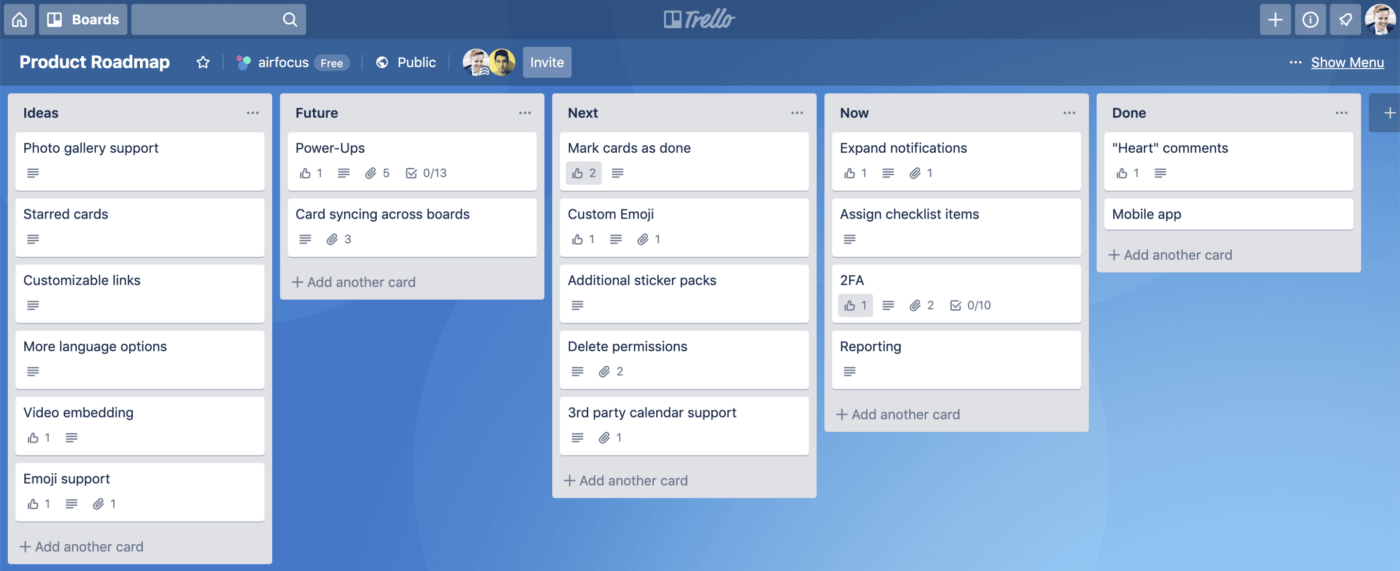
What is Trello?
As Trello’s parent company Atlassian explains on its website: “Trello is a collaboration tool that organizes your projects into boards.”
So, again, we’ve found a solution focused on project management — not product management.
In fact, the four primary use cases listed on Trello’s main product page are: project management, meetings, onboarding, and task management.
Product management, anyone?
Trello pros:
- Outstanding app for cross-team collaboration.
- Simplifies project management for complex company initiatives.
- Intuitive interface makes it easy to implement and use.
Trello cons:
- Not designed for product management.
- Offers only very basic roadmapping functionality with little flexibility in views or presentation modes.
- Does not include built-in prioritization frameworks, feedback collection, capacity planning, or other key strategic product management workflows.
Conclusion
As we hope we’ve demonstrated, Productboard is similar to many of the apps out there presenting themselves as “product management software solutions.” Most of them offer some of the functionality a Product Manager like you probably needs — but fall far short of creating an end-to-end digital hub for your product team’s important strategic work.
If you want to implement such a solution, rather than signing up for multiple tools to address your team’s different workflows, check out our free Product Management Platform Buyer’s Guide.

